Angiosperms & Pre-Fertilisation: Structure & Events | Biology Class 12 - NEET PDF Download
Introduction to Parts of a Flower
Flowering plants, also called angiosperms, use a sexual mode of reproduction. Reproduction in plants, mainly revolves around the flower, which has both the male and the female gametes. All parts of a flower aid in the process of reproduction, although some of them are sterile. Therefore, to understand the process of reproduction in flowering plants, we need to look at the different parts of the flower and their functions.
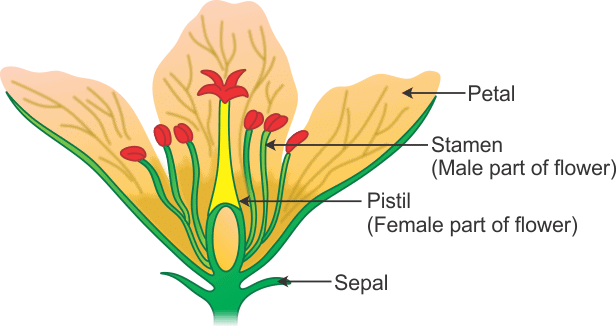 Diagrammatic Representation of Longitudinal Section (LS) of a Flower
Diagrammatic Representation of Longitudinal Section (LS) of a Flower
Flower comprises of the following parts:
- Calyx: It is the outermost whorl of a flower. It comprises units called sepals. In the bud stage, calyx encloses the rest of the flower. They usually exhibit green colouration, at some other instances, they may be a colour like petals. This state of Calyx is termed as petaloid. Calyx can either be prominent or absent.
- Corolla: It consists of many numbers of petals and it is the second whorl of the flower. These petals are sometimes fragrant. They are coloured, thin and soft that would help in the process of pollination as they would attract animals and insects.
- Stamen: the male reproductive part comprises the anther and filament.
- Pistil: the female reproductive part comprising three parts – stigma, style, and ovary.
- Sepals and Petals: The sepals and petals together make up the perianth, or floral envelope. The sepals are usually greenish and often resemble reduced leaves, while the petals are usually colourful and showy.
- Pedicel: Pedicel refers to a structure connecting a single flower to its inflorescence. In the absence of a pedicel, the flowers are described as sessile.
What are Angiosperms?
- Angiosperms are vascular plants with stems, roots, and leaves. The seeds of the angiosperm are found in a flower.
- These make up the majority of all plants on earth. The seeds develop inside the plant organs and form fruit. Hence, they are also known as flowering plants.
- Angiosperms are the most advanced and beneficial group of plants. They can grow in various habitats as trees, herbs, shrubs, and bushes.
Classification of Angiosperms
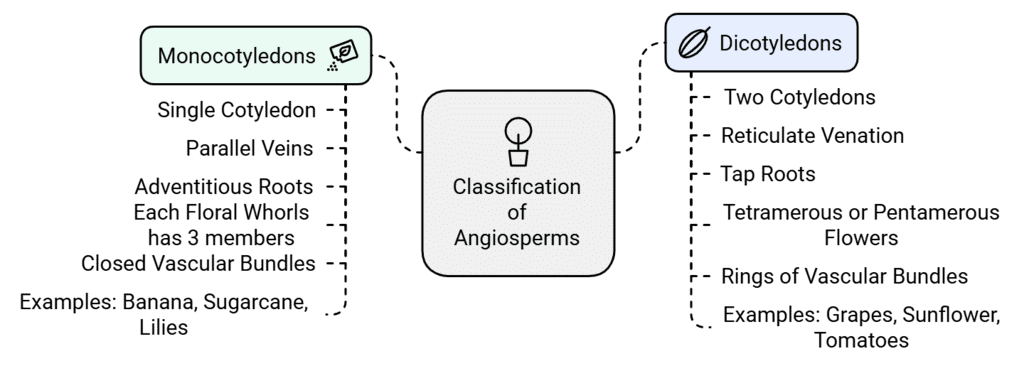 Classification of Angiosperms
Classification of Angiosperms
Characteristics of Angiosperms
- Most of the important Angiospermic characters are found in Capsella so that for the study of Angiosperms, it is considered as a "Typical Angiosperm".
- It is an annual plant and grows like a weed during the winter season in the field.
The main plant of the Capsella is a sporophyte, which is diploid and it is differentiated into root, stem and leaves.
Capsella is a heterosporous plant it means there are two different types of spores are formed in the life cycle which is classified into two categories in which male spores are called Microspores and female spores are called Megaspores.
The process of reproduction takes place in this plant through a special structure, called a flower.
Calyx, Corolla, Androecium and Gynoecium are present in the typical or complete flower.
The calyx and corolla are termed accessory whorls of the flower because these structures do not participate in the process of reproduction, they only help.
The androeciumandgynoecium are known as essential whorls because they are directly related to reproduction.
Angiosperms - Points to Remember
- Angiosperm originated in the Mesozoic era. Angiosperm originated either in the beginning of the Cretaceous period or in the ending of the Jurassic period of the Mesozoic era. It means they are originated between the Cretaceous and the Jurassic period on the earth.
- Angiosperm dominated over the earth in the Cenozoic era. So this era is known as the "Golden Period of Angiosperms".
- First of all, N.Grew realized the fact, Stamens are male sex organ of flower (Anatomy of plants).
- Sexuality in plant first of all reported by Jacob Camerarius.
- He reported Anthers are the male sex organ and Ovary with style and stigma are female sex organ, and for the formation of seed, interaction is essential in between both the sex organs.
- The significance of pollination and the role of insects in pollination was recognized by Joseph Kolreuter.
- Prof. P. Maheshwari - Father of Indian plant Embryology. He wrote a book – 'An Introduction to Embryology of Angiosperms'.
Sexual Reproduction in Flowering Plants
- In Angiosperms, male and female gametes are formed in male and female sex organs by the process of meiosis.
- Both the gametes fuse together to form a diploid zygote which gives rise to the embryo. The process in which an embryo is formed by meiosis and fertilization is called Amphimixis.
Male Reproductive Organ: Androecium
- The male reproductive organ is called the androecium and their unit is called the stamen.
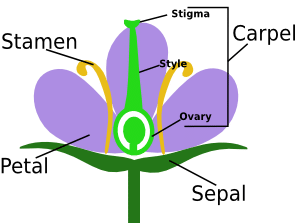 Structure of Androecium
Structure of Androecium - Stamen is also known as microsporophyll. There are 6 stamens in Capsella.
- A typical stamen is differentiated into three parts:
i) The thin structure is called filament which joins the stamen to the thalamus.
ii) The free end of the filament, a swollen spore-bearing structure is called the anther.
iii) Anther and filament are attached together with help of a small region, called connective. Connective contains vascular tissues. - The main part of the stamen is anther. Each anther generally bilobed structure i.e., anther has two other lobes, called dithecous. Each lobe of anther has two chambers which are called pollen sacs orpollen chambers.
- Therefore, a typical anther has four pollen sacs called tetrasporangiate.
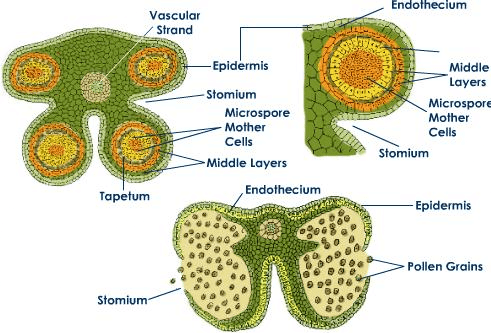 Traverse Sectional View of Tetrasporangiate (Labelled Diagram)
Traverse Sectional View of Tetrasporangiate (Labelled Diagram)
- Pollen grains are formed inside the pollen sac through the meiotic division in pollen mother cells.
- At the maturity of the pollen grains, sterile tissue degenerate which is present in between the pollen sacs. Both the pollen sac fused together. Because of this reason, only one chamber appears in each anther lobe at maturity. So two chambers are seen in the mature anther at the time of dehiscence.
- In Capsella, which is a member of the Cruciferae or Brassicaceae, anther is dithecous and tetrasporangiate type.
- But in Malvaceae, the anther of stamen has only one anther lobe. This is called monothecous and it contains only two pollen sacs called Bisporangiate.
- Monothecous anther is also found in Moringa, Wolffia plants.
- In Arceuthobium where there is only one microsporangium per anther. This condition is calledMonosporangiate.
Types of Structure in Anther
- The development of anther in origin is the Eusporangiate type i.e. it is developed from more than one archesporial cells.
- In the transverse section of an anther, it is seen as almost spherical.

1) Epidermis
It is the outermost layer of the anther. It is a single-celled thick and continuous layer but not archesporial in origin. It forms the outermost protective layer
In Arceuthobium (Smallest Parasitic Angiosperm) fibrous thickening present in the epidermis so it is called exothecium.
2) Endothecium
This layer is present below the epidermis. It is a single-celled thick layer. During the maturation of anther, various changes take place in different walls of cells of endothecium. The outer wall of these cells remains thin-walled, but inner walls and radial walls become thick due to the thickening of cellulose fibres.
Callose bands are also present along the radial walls. At some places callose bands and fibrous thickening are absent. These places are called stomium. The dehiscence of anther takes place only from these places. Endothecium becomes hygroscopic in nature due to the presence of fibrous thickening. So it helps in dehiscence of the anther.
Note:In the Hydrocharitaceae family, fibrous thickening is absent in endothecium.
3) Middle layer
Middle layer consists of parenchymatous cells. This layer is one to three celled thick structure.Food is stored by parenchymatous cells in this layer. The middle layer is ephemeral in nature and absent in a mature anther.
Note
- In Holoptelia plant 3 to 4 celled thick middle layer is present.
- In Najadaceae & Lemnaceae families middle layer is absent.
- In Wolffia middle layer is absent.
4) Tapetum
It is the innermost layer that acts as a nutritive layer. Pollen sacs are surrounded by tapetum. This is also a single-celled thick layer. The cells of the tapetum initially diploid but they become polyploid and multinucleate due to endomitosis, free nuclear division and polyteny. It means these cells contain many chromosomes. Tapetum absorbs food from the middle layer and provides nutrition to the microspore mother cells or microspores. The cells of the tapetum secretehormones and enzymes. The tapetum layer disappears in the mature anther.
Note:
In Nicodia and Costum plants, tapetum is multilayered.
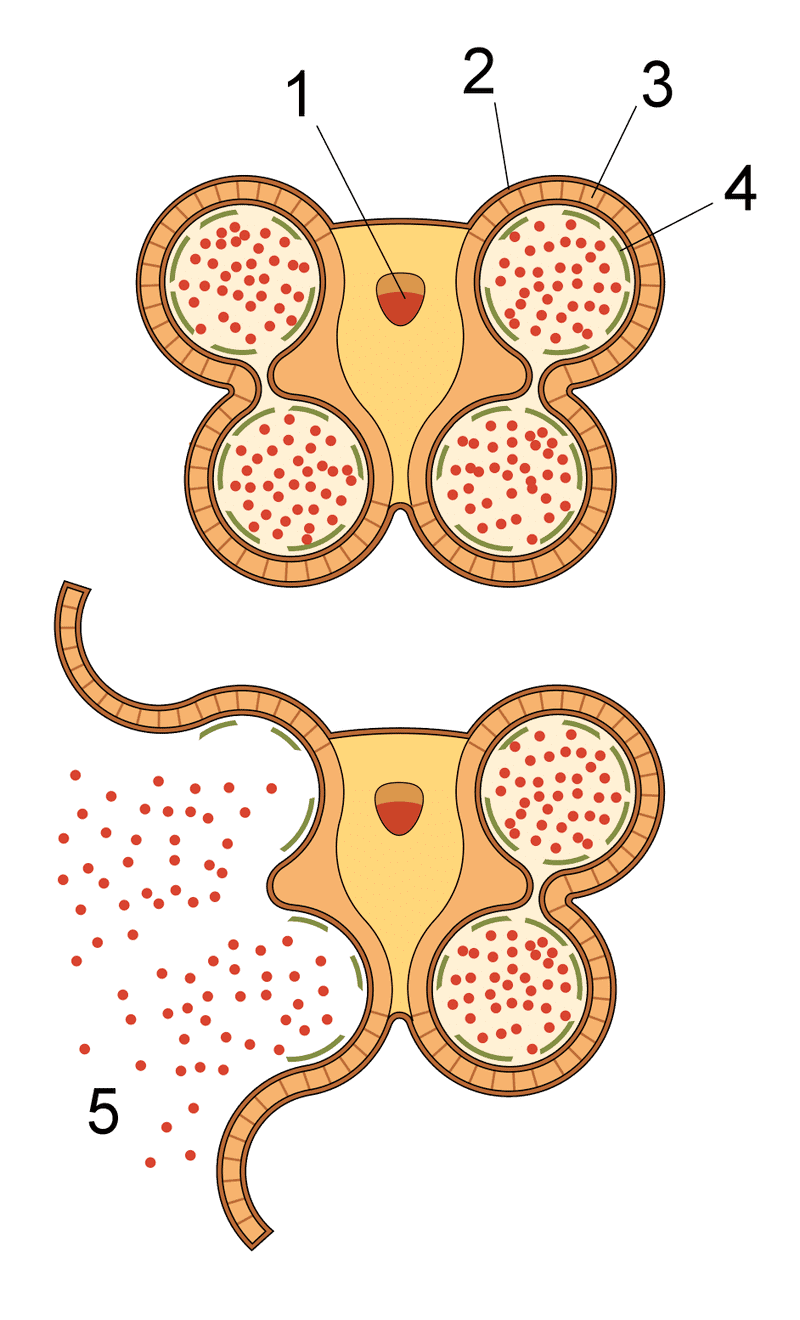 Section of an anther, showing dehiscence and release of pollen
Section of an anther, showing dehiscence and release of pollen
1: Vascular bundle
2: Epidermis
3: Fibrous layer
4: Tapetum
5: Pollen
5) Pollen sacs
Four Pollen sacs are present in the anther. Pollen sacs are also known as microsporangia. Inside the pollen sacs, microspores are formed by the meiotic division of microspore mother cells.
Female Reproductive Organ: Gynoecium
- The gynoecium is the female reproductive organ.The free unit of gynoecium is calledpistil or carpel.The carpel is also known as megasporophyll.
- The carpel is differentiated into three distinct regions:
(i) Stigma
(ii)Style
(iii) Ovary
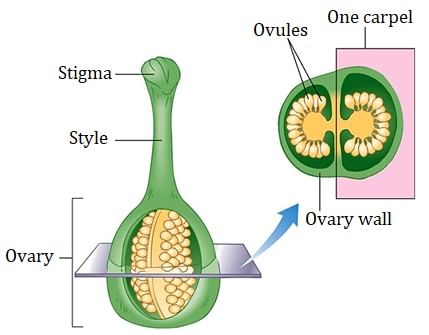 Structure of Carpel or Pistil
Structure of Carpel or Pistil
- The free end of the carpel which receives pollen grains is called stigma.
- A long, narrow tubular structure is present in between the stigma and ovary called style. The basal swollen part of the carpel is called the ovary.
- The ovules are also known as megasporongiawhich are borne on a cushion-like tissue called the placenta in the ovary. One or more than one ovules are present inside the ovary.
- The gynoecium of the Capsellais bicarpellary, syncarpous, unilocular and superior. It becomes bilocular due to the formation of false septum or replum at maturity.
Difference between male and female gametophyte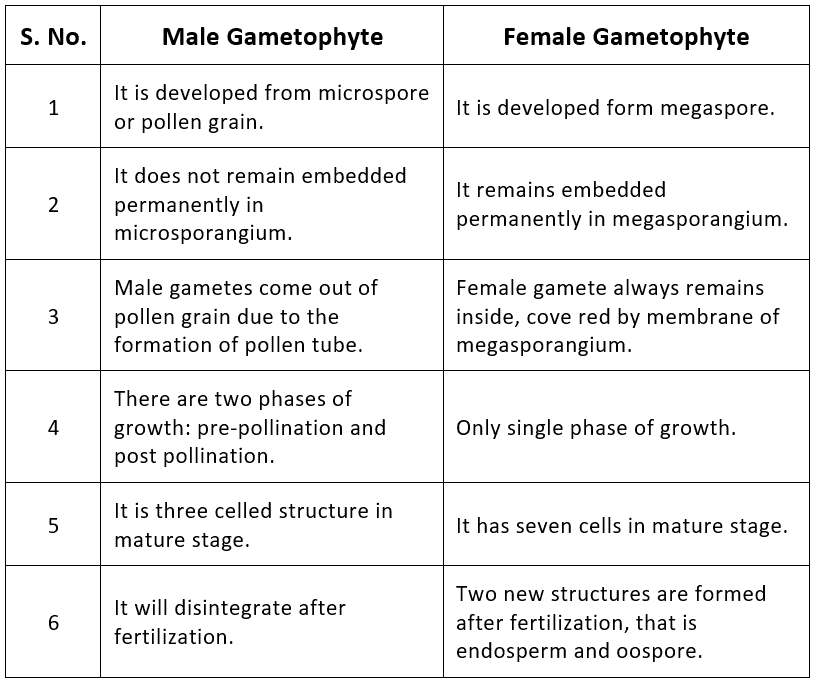
Flower as a Modified Shoot
- According to Goethe, Flower is a modified shoot that shows favourable adaptation for reproduction through a special method.
- The flower has a small or long stalk-like structure called a pedicel. The free end of the pedicel is flattened or dome-shaped is called the thalamus. The thalamus is a type of modified stem, on which nodes and internodes are present.
- The whorls present in the flower are the modifications of leaves and arranged in four circles on the thalamus.
- The four nodes are present on the thalamus, in which the first modified leaves are attached on the first lower node are called the calyx.
- The corolla born on the second node.
- The androecium is present on the third node and gynoecium on the fourth node in the uppermost position.
Monocarpic Plants
- The plants in which floweringandfruiting take place only once in the whole life cycle are called monocarpic.
Example: Annual & Biennial plants.
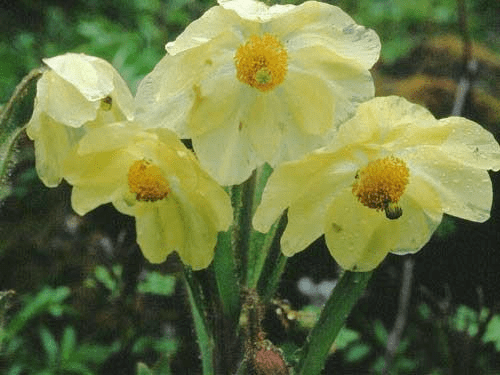 Monocarpic Plant
Monocarpic Plant
Polycarpic Plants
- The plants in which flowering and fruitingtake place many times in the entire life cycle are known as polycarpic.
Example:Perennial plant.
Exception: Bamboo, Palms, Banana, Century plant (Agave americana) are perennial plants but they are the example of monocarpic plants.
Old NCERT Syllabus
Two Types of Tapetum
(a) Amoeboid Tapetum/Invasive Tapetum/Periplasmodial Tapetum
- It is found in primitive Angiosperm. Such type of tapetum absorbs all foods from the middle layer. So the middle layer immediately degenerates. In the beginning, all food materials stored by tapetum.
- Tapetal cells convert absorbed food into special food granules called protoplast bodies. The innermost layer of the tapetum dissolves and release its protoplast into the cavity of the microsporangium. Now inside the pollen sacs, protoplast bodies are known as periplasmodium.
- Microspore mother cells are surrounded by periplasmodium and provide nourishment to the developing microspores. This type of tapetum provides nutrition to the microspores after degeneration.
Example:Typha, Alisma and Tradescantia.
(b) Glandular Or Secretory Tapetum
- It is an advanced type of tapetum. It does not degenerate quickly. It absorbs nutrients from the middle layer and secretes them into the cavity of the microsporangia (Pollen sacs) and does not store it e.g. Usually it is found in most of the Flowering plants(Capsella).
- Before degeneration of cells of the tapetum, they form special granules called Proubisch bodies in the cytoplasm. Proubisch bodies transfer between the cell wall and cell membrane of tapetal cells. Here they are surrounded by sporopollenin. Now they are called Ubisch bodiesororbicules.
- At last tapetum degenerates and ubisch bodies released into pollen sacs. Generally, sporopollenin participates in the formation of outer covering (Exine) of Pollen grains.
Note:
Tapetum helps in transfer of food, storage of food, formation of sporopollenin and pollen kit materials.
|
59 videos|290 docs|168 tests
|
FAQs on Angiosperms & Pre-Fertilisation: Structure & Events - Biology Class 12 - NEET
| 1. What are angiosperms and how do they differ from other types of plants? |  |
| 2. What are the main classifications of angiosperms? |  |
| 3. What are the key characteristics of angiosperms? |  |
| 4. How does sexual reproduction occur in flowering plants? |  |
| 5. What role does the flower play as a modified shoot in angiosperms? |  |

















